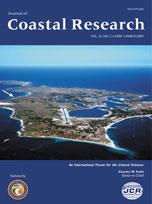Low-energy beaches are omnipresent coastal features. In total, their overall length greatly exceeds that of ocean shorelines throughout the world. However, a comprehensive understanding of low-energy beaches is lacking, with their dynamics generally considered under existing principles governing open ocean beaches. This study investigates the morphodynamic characteristics of very low energy beaches on which wave heights can be less than 0.15 m under nonstorm conditions, as distinguished from the characteristic of high-energy environments in which low energy states commonly have modal wave heights of 0.5–1 m. This investigation is achieved through an analysis of a 30-year profile data set for Cockburn Sound, a fetch-limited, low-energy basin in southwestern Australia. The Sound experiences the full ranging of microtides and surges of the region, together with locally generated wind waves. Recurring patterns in cross-shore geometries and their distribution were identified through regression analysis of mean profile shapes. The spatial variability in the wind-wave regime was established by hindcasting conditions for key fetch directions. Cluster analysis of profile and environmental variables identified four morphotypes. Each morphotype can be explained in terms of a simple exposure factor, Ef = log(Fl/Ms), which is the proportion of fetch length (Fl) to marginal shoal width (Ms), such that Ef < 1 was characteristic of exponential profiles, Ef = 1–1.5 of segmented profiles, Ef = 1.5–2 of concave-curvilinear profiles, and Ef > 2 of convex-curvilinear profiles. Thus, the exposure factor is identified as a useful nondimensional parameter for the delineation of low-energy profile morphotypes within the study area. The utility of this approach in widespread classifications of low-energy beach morphology requires further research. This should take place in a variety of environments with varying degrees of protection and shelter from swell and subject to different tidal ranges and fluctuations in sea level.
How to translate text using browser tools
1 March 2007
Low-Energy Beach Morphology with Respect to Physical Setting: A Case Study from Cockburn Sound, Southwestern Australia
Ailbhe Travers
ACCESS THE FULL ARTICLE

Journal of Coastal Research
Vol. 2007 • No. 232
March 2007
Vol. 2007 • No. 232
March 2007
exposure factor
fetch-restricted beaches
Morphotypes
sandy beaches
sheltered beaches




